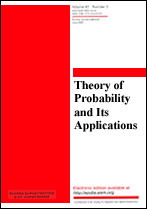|
This article is cited in 6 scientific papers (total in 6 papers)
Localization transition for a copolymer in an emulsion
F. den Hollanderab, S. Whittingtonc
a Eurandom
b Leiden University
c University of Toronto
Abstract:
In this paper we study a two-dimensional directed self-avoiding walk model of a random copolymer in a random emulsion. The polymer is a random concatenation of monomers of two types, $A$ and $B$, each occurring with density $\frac12$. The emulsion is a random mixture of liquids of two types, $A$ and $B$, organized in large square blocks occurring with density $p$ and $1-p$, respectively, where $p \in (0,1)$. The polymer in the emulsion has an energy that is minus $\alpha$ times the number of $AA$-matches minus $\beta$ times the number of $BB$-matches, where $\alpha,\beta\inR$ are interaction parameters. Symmetry considerations show that without loss of generality we may restrict our attention to the cone $\{(\alpha,\beta) \inR^2:\alpha\ge|\beta|\}$. We derive a variational expression for the quenched free energy per monomer in the limit as the length $n$ of the polymer tends to infinity and the blocks in the emulsion have size $L_n$ such that $L_n\to\infty$ and $L_n/n\to 0$. To make the model mathematically tractable, we assume that the polymer can only enter and exit a pair of neighboring blocks at diagonally opposite corners. Although this is an unphysical restriction, it turns out that the model exhibits rich and physically relevant behavior. Let $p_c \approx 0.64$ be the critical probability for directed bond percolation on the square lattice. We show that for $p \ge p_c$ the free energy has a phase transition along one curve in the cone, which turns out to be independent of $p$. At this curve, there is a transition from a phase where the polymer is fully $A$-delocalized (i.e., it spends almost all of its time deep inside the $A$-blocks) to a phase where the polymer is partially $AB$-localized (i.e., it spends a positive fraction of its time near those interfaces where it diagonally crosses the $A$-block rather than the $B$-block). We show that for $p<p_c$ the free energy has a phase transition along two curves in the cone, both of which turn out to depend on $p$. At the first curve there is a transition from a phase where the polymer is fully $A,B$-delocalized (i.e., it spends almost all of its time deep inside the $A$-blocks and the $B$-blocks) to a partially $BA$-localized phase, while at the second curve there is a transition from a partially $BA$-localized phase to a phase where both partial $BA$-localization and partial $AB$-localization occur simultaneously. We derive a number of qualitative properties of the critical curves. The supercritical curve is nondecreasing and concave with a finite horizontal asymptote. Remarkably, the first subcritical curve does not share these properties and does not converge to the supercritical curve as $p\uparrow p_c$. Rather, the second subcritical curve converges to the supercritical curve as $p\downarrow 0$.
Keywords:
random copolymer, random emulsion, localization, delocalization, phase transition, percolation, large deviations.
Received: 15.12.2005
Citation:
F. den Hollander, S. Whittington, “Localization transition for a copolymer in an emulsion”, Teor. Veroyatnost. i Primenen., 51:1 (2006), 193–240; Theory Probab. Appl., 51:1 (2007), 101–141
Linking options:
https://www.mathnet.ru/eng/tvp154https://doi.org/10.4213/tvp154 https://www.mathnet.ru/eng/tvp/v51/i1/p193
|


| Statistics & downloads: |
| Abstract page: | 347 | | Full-text PDF : | 163 | | References: | 71 |
|




 Contact us:
Contact us: Terms of Use
Terms of Use
 Registration to the website
Registration to the website Logotypes
Logotypes








 Citation in format
Citation in format 
